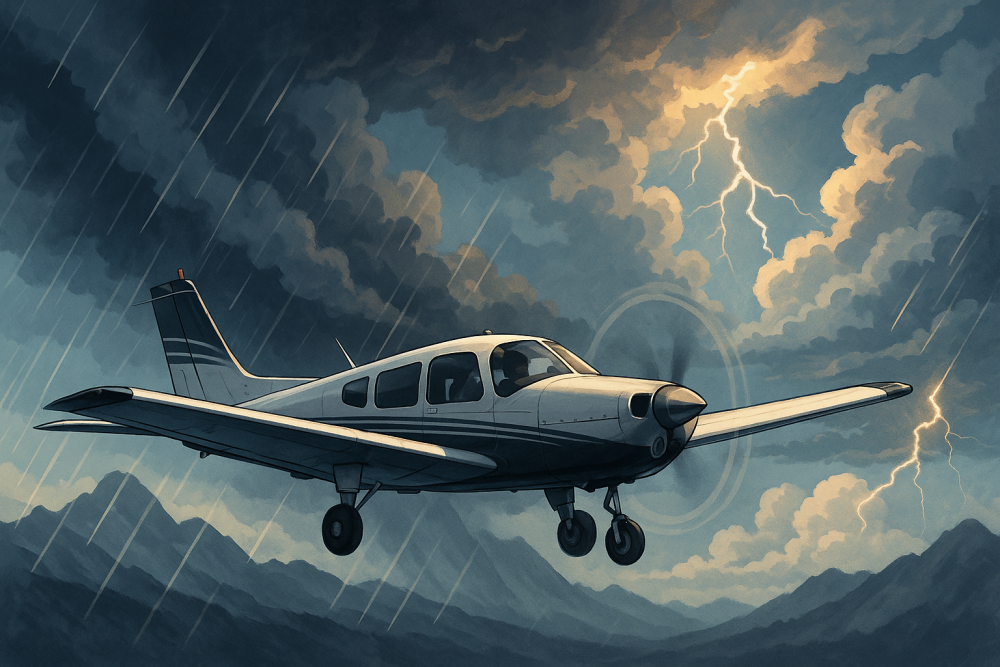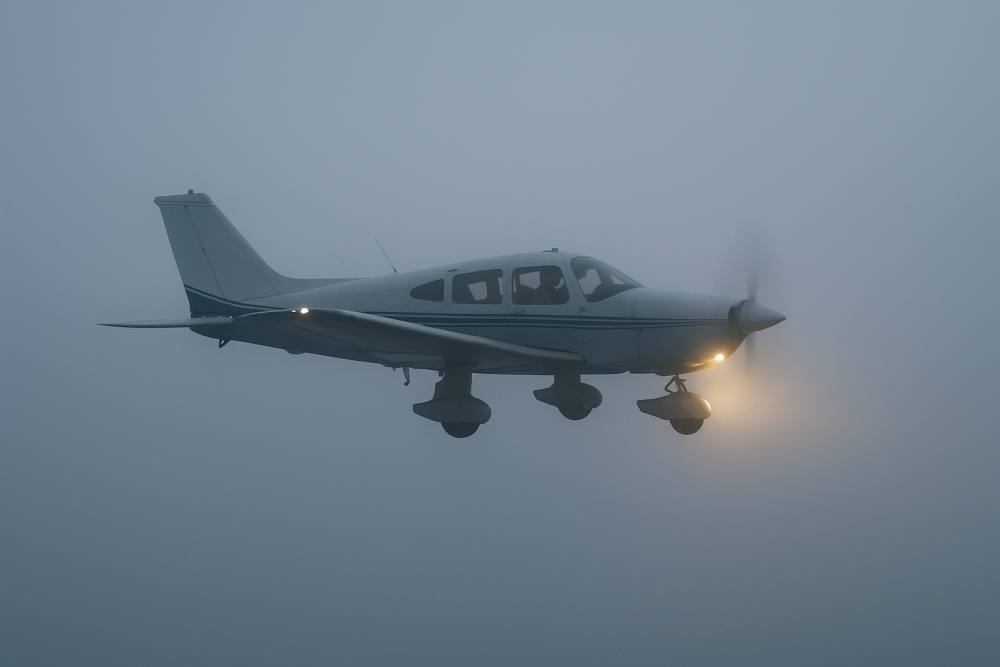
Using custom weather settings can seriously up your flight sim game. Imagine navigating through a virtual storm or adjusting your flight path due to a looming cold front. When these elements come into play, you’re not just flying; you’re taking on the role of a real-world pilot adapting to Mother Nature’s whims. 👉 Learn how to customize weather in MSFS 2020 for maximum realism.
🎥 Video Learn & Fly: Weather Realism in Action
This video breaks down how to use custom weather settings in your sim — from dramatic storms and wind shifts to icing and turbulence — so you can experience and master the kinds of weather scenarios real pilots train for.
Experiencing frontal systems in your sim isn’t just about seeing a shift in the clouds. Frontal systems bring dramatic changes, like temperature drops and wind shifts, which affect your flight plans and tactics. It’s about interpreting these changes and adjusting your strategy on-the-fly. Challenge yourself by setting up scenarios where a warm front meets a cold front and watch how the weather tests your piloting skills.
Nobody likes icing in real life, but in a sim, it’s a fantastic learning opportunity. By flying into known icing conditions, you can witness how it affects lift, drag, and your aircraft’s overall performance. Then, practice reversing course or climbing to a safer altitude as you’d need to do in reality.
👉 You might also enjoy: Exploring Realistic Weather Mods For Added Challenge.
Tackling convective weather throws you into the heart of unpredictability. Thunderstorms, gusty winds, and rolling turbulence aren’t just visual effects—they force you to stay sharp, make quick calls, and adapt mid-flight. You’re not just flying through bumpy skies; you’re sharpening your instincts where every second counts.
Mastering the Art of METAR/TAF Interpretation for Flight Planning
Understanding METARs and TAFs might seem complex, but once you get the hang of them, they become your best buddies in planning a flight. These weather reports are like the fine print of the sky—packed with details about what to expect long before you hit the runway.
👉 Check live METAR/TAF data via AviationWeather.gov.
When you’re reading a METAR, think of it as a snapshot of current weather at an airport. Decoding the acronyms and symbols can feel like cracking a code, but it’s all about getting familiar with the basics like wind speed, temperature, visibility, and cloud cover. Once you’ve got that down, tailor your flight plan by comparing this data to the actual conditions.
TAFs, or Terminal Aerodrome Forecasts, offer a forecasted glimpse into what the skies might throw at you next—from shifting winds to looming storms. When you adjust your departure or tweak your route based on a TAF, it turns your session into a dynamic, decision-driven flight that mirrors what real pilots do every day.
Recreating briefings using real or simulated METAR and TAF reports isn’t just about sounding like a pro. This routine builds confidence to adjust your plans in a snap, whether you’re inches from the runway or zipping through the clouds.
Many folks trip up on common misinterpretations. A METAR might show great visibility at ground level, but a glance at the TAF reveals turbulence at your cruising altitude. Being aware of the potential for these differences helps avoid unexpected challenges in-flight, making you as adaptable as pilots knocking hours in real cockpits.
Handling Adverse Weather Scenarios: Skills Beyond Basics

When you’re pushing the envelope in a flight simulator, tackling some serious weather issues can make you feel like a seasoned pilot in training. Moving past simple takeoffs and landings means it’s time to grapple with challenges like density altitude and wind shear.
👉 If you’re new to sim challenges, check out: Common Mistakes New Flight Simulator Users Make.
Density altitude isn’t just a fancy term for pilots to throw around. It’s a crucial factor that affects your aircraft’s performance, especially in high-altitude and hot weather conditions. When simulating these scenarios, experience how it feels when your aircraft struggles during takeoff or climb. Practicing adjustments can give you insights into real-world flight dynamics, making your skills far more rounded.
Wind shear—the kind of sudden jolt that can throw off even experienced pilots—deserves serious attention. Set up a few scenarios with sneaky tailwind gusts or rapid shifts, and you’ll quickly see why it’s no joke. Practicing your recovery moves in a sim builds real confidence for handling turbulence when it hits out of nowhere.
👉 See how real-world pilots train for wind shear.
Taking on mountain wave and rotor scenarios means wrestling with turbulence that mimics real-life conditions. Picture yourself flying over a mountain range with strong winds causing your aircraft to ride an unseen roller coaster. It’s exhilarating and tests your ability to maintain control in the face of nature’s chaos.
Icing isn’t just a winter hazard; it’s a learning scenario that tests your strategic thinking. Flying into known icing conditions might seem counterintuitive, but it’s a lesson in handling sudden performance drops. Practicing safe escape maneuvers builds confidence and resilience when faced with adverse environmental conditions, all from the comfort and safety of your simulator.
Enhancing IFR Skills in Poor Visibility Conditions

Flying with limited visibility isn’t just a technical skill; it’s a mental game of trust and precision. When the world outside your cockpit disappears into a misty haze, your ability to rely on instruments becomes your superpower. Preparing for these conditions in a simulator is your chance to hone nerves of steel.
👉 Want to learn more? Read: Masterclass: Instrument Flight Rules In Sims.
Getting the hang of instrument departures and approaches might be challenging at first, but imagine guiding your plane safely by relying purely on the dials and gauges. Practicing these will make the transition between instruments and visual cues smooth, ensuring you’re prepared when Mother Nature dims the stage lights.
Instrument Meteorological Conditions (IMC) allow you to embrace unpredictability head-on. Flying long cruises under these hazy skies demands focus and fosters an intuitive bond between you and the controls. It’s all about building comfort in discomfort and gaining confidence when the horizon disappears.
Low visibility flights are all about keeping cool when you can’t see a thing. It’s your chance to try out different approach techniques, make mistakes, and refine your instincts—without risking anything. The more you fly into the fog, the more confident you’ll feel guiding your aircraft through the haze.
Incorporating alternate airports and planning for extra fuel margins during your flight is about expecting the unexpected. When visibility is low and weather turns sour, knowing you have a Plan B tucked away keeps stress levels down and options open. It’s about going beyond surviving a flight to mastering your own crisis management strategies.
Reassessing and Refining Flight Skills through Regular Debriefing
Something magical happens when you wrap up a challenging flight simulation—it’s time to debrief. Think of reviewing your simulated flights as the key to unlocking your full potential as a pilot. It’s not just about analyzing; it’s about learning and evolving with every session.
Recording your flight enables a fresh perspective on your decision-making. Watching replays isn’t just entertaining. It’s informative. You get to see your reactions to different weather scenarios and how you handle them. This process helps in spotting tendencies to improve or areas needing a bit of finesse.
👉 Consider recording your sessions with tools like SkyDemon or ForeFlight for real-time weather and tracking.
Simulation has this beautiful thing called near-miss scenarios. These close-runs let you scrutinize decision-making under stress and see where plans fumble. It’s not about flaws; it’s about figuring out smarter strategies and thinking ahead.
A thriving pilot knows the value of constructive feedback. When you look back on simulations, especially the rough patches, you get to refine your methods. It’s a chance to take notes, re-plan, and act on insights from each session.
Turning debriefing into a habit is where real growth happens. It’s not just about spotting mistakes—it’s about tracking your progress, celebrating the small wins, and building better habits. Over time, you’ll notice sharper instincts, quicker decisions, and a mindset that mirrors real-world aviators.
✈️ Final Thoughts: Weathering the Sim Like a Pro
Diving into challenging weather scenarios isn’t just about pushing sliders or adding fog—it’s about stepping into the mindset of a real pilot. From interpreting METARs and TAFs to wrestling with turbulence, icing, and low visibility, your simulator becomes more than just a game. It turns into a training ground where your reflexes, planning, and decision-making skills all get a serious upgrade.
So next time you fire up your sim, don’t just fly in clear skies. Build a storm. Chase a front. Navigate an approach in the thick of the clouds. And when you’re done, watch the replay, take notes, and get better—because that’s how real-world skill and sim mastery come together.
💬 What’s the wildest weather scenario you’ve ever flown through? Share it in the comments, and don’t forget to check out Masterclass: Instrument Flight Rules In Sims for a deeper dive into IFR techniques in tough conditions.
Ready to take your sim skies to the next level? Start by setting your own custom storm—then fly through it like you mean it. 🌩️🛫
